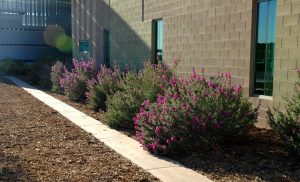Have you ever driven by a landscape with shrubs that have been pruned into rounded shapes? You may be surprised to find out that maintaining shrubs this way is often not only unnecessary but uses more water than shrubs pruned infrequently.
What are some of the other ill effects of excessive pruning?
- Plants grow faster in their attempt to re-grow the leaves that were pruned away.
- More maintenance is required due to the fact that shrubs grow faster.
- More water is used by the plant as it devotes resources to replacing leaves lost to pruning.
- Flowering shrubs are downgraded to round, green shapes with few leaves and flowers.
- Excessive and unnecessary green waste is created.
- Shrubs decline due to the stress of constantly growing back leaves lost to pruning.
So, what can you do to avoid the need to frequently prune your shrubs?

- Learn how large your shrubs will become and allow enough room for them to grow. For example, if your chosen shrub(s) grow to 6 ft. tall and wide, then plant them at least 7 feet apart and in an area where they won’t impede your view. You can find a list of shrubs and their mature sizes in the Landscape Plants for the Arizona Desert online plant database.
- Reduce the number of excess shrubs in the landscape. If your landscape cannot fit all of the plants in it without having to resort to frequent pruning, you can selectively remove some of the shrubs in order to allow those that remain to grow larger without having to constantly prune them.
- Prune flowering shrubs once a year or less. It may surprise you to learn that shrubs do not need to be pruned on a regular basis. As long as your shrub(s) have enough room to grow – proper pruning will be focused on plant health and removing old, woody growth (most flowering shrubs can be pruned back in early spring). Throw away your hedge-trimmers and use hand pruners or loppers. Find helpful guidelines on how to prune and maintain flowering shrubs through this shrub guide from the University of Arizona Cooperative Extension.
And, what should you do if you already own over-sheared shrubs?
If your landscape is filled with overgrown, formally pruned shrubs – you can start over. In early spring you can severely prune back flowering shrubs to 18 inches. This type of severe pruning rejuvenates shrubs and stimulates new growth that can be maintained with infrequent pruning, focusing on keeping the natural, attractive shape of the flowering shrub. You may lose a few of your shrubs doing this, but the results are well worth the risk.
By avoiding the practice of excessive pruning, you will not only save water, money and time – you’ll have an attractive landscape with beautiful, naturally-shaped, flowering shrubs instead of a landscape filled with boring, green ‘balls’.
From time to time, Water – Use It Wisely features guest bloggers who write about topics related to water and water conservation. Noelle Johnson is an urban horticulturist, Certified Arborist and freelance garden-writer who helps people create beautiful, low-maintenance gardens through helpful advice on her blog www.azplantlady.com. She is passionate about teaching people that flowering shrubs aren’t meant to be balls, cupcakes or square-shaped. When she is not writing or helping other people with their landscapes, you can find her “playing” outside growing fruits and vegetables, and planting flowering shrubs and maybe a cactus or two.


